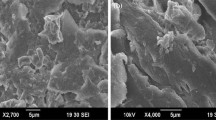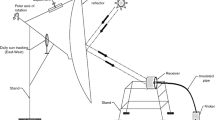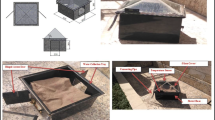Abstract
In this communication, experiments have been performed to check the capability of the newly formed composite desiccant material (CaCl2/floral) for the extraction of freshwater from atmospheric air. Three numbers of solar glass desiccant box type system (SGDBS) with a captured area of 0.36 m2 each, have been used. The design parameters for the water production are height of glass from desiccant bed at 0.22 m, inclination in angle as 30°, the effective thickness of glass as 3 mm and number of glazing as single. The maximum yield by the new composite desiccant material is 0.35 ml/cm3/day. The efficiency of the system SGDBS with 37 % concentration of CaCl2 is 76.44 %.











Similar content being viewed by others
Abbreviations
- CRF:
-
Capital recovery factor
- G a :
-
Adsorption rate (kg/h)
- L :
-
Latent heat of water at average bed temperature (J/kg)
- M sol :
-
Mass of solution (kg)
- M s :
-
Mass of salt (kg)
- M w :
-
Mass of water (kg)
- m ws :
-
Weight of desiccant on wet basis (kg)
- n :
-
Number of useful years
- P :
-
Initial investment
- r%:
-
Annual rate of interest
- S :
-
Salvage value
- SFF:
-
Sinking fund factor
- w :
-
Moisture content in desiccant (kgwater vapor/kgdesiccant)
- X :
-
Concentration of solution
References
Abualhamayel, H. I., & Gandhidasan, P. (1997). A method of obtaining fresh water from humid atmosphere. Desalination, 113, 51–63.
Alayli, Y., Hadji, N. E., & Leblond, J. (1987). A new process for extraction of water from air. Desalination, 67, 227–229.
Aristov, Y. I., Tokarev, M. M., Gordeeva, L. G., Snytnikov, V. N., & Parmon, V. N. (1998). New composite sorbents for solar driven technology of fresh water production from the atmosphere. Solar Energy, 66, 165–168.
Audah, N., Ghaddar, N., & Ghali, K. (2011). Optimized solar-powered liquid desiccant system to supply building fresh water and cooling needs. Applied Energy, 88, 3726–3736.
Bar, E. (2004). Extraction of water from air—An alternative solution for water supply. Desalination, 165, 335.
Dawoud, B., & Aristov, Y. (2002). Experimental study of water vapor sorption on selective water sorbents, silica gel and alumina under typical operating conditions of sorption heat pump. International Journal of Heat and Mass Transfer, 46, 273–281.
Gad, H. E., Hamed, A. M., & Sharkawy, I. I. (2000). Application of solar desiccant/collector system for water recovery from atmospheric air. Renewable Energy, 22, 541–556.
Gordeeva, L. G., Restuccia, G., Ferni, A., & Aristov, Y. I. (2002). Water sorption on composites “LiBr in a porous carbon”. Fuel Processing Technology, 79, 225–231.
Govind, & Tiwari, G. N. (1984). Economic analysis of some solar energy systems. Energy Conversion and Management, 24, 131–135.
Hamed, A. M. (1999). Absorption–regeneration cycle for production of water from air-theoretical approach. Renewable Energy, 19, 625–635.
Hamed, A. M. (2002). Theoretical and experimental study on the transient adsorption characteristics of a vertical packed porous bed. Renewable Energy, 27, 525–541.
Hamed, A. M. (2003). Experimental investigation on the natural absorption on the surface of sandy layer impregnated with liquid desiccant. Renewable Energy, 28, 1587–1596.
Hamed, A. M., Aly, A. A., & Zeidan, B. E.-S. (2011). Application of solar energy for recovery of water from atmospheric air in climatic zones of Saudi Arabia. Natural Resources, 2, 8–17.
Ji, J. G., Wang, R. Z., & Li, L. X. (2007). New composite absorbent for solar-driven fresh water production from the atmosphere. Desalination, 212, 176–182.
Kabeel, A. E. (2007). Water production from air using multi-shelves solar glass pyramid system. Renewable Energy, 32, 157–172.
Kumar, A., Chaudhary, A., & Yadav, A. (2014). The regeneration of various solid desiccant by using the parabolic dish collector and adsorption rate: An experimental investigation. International Journal of Green Energy, 11, 936–953.
Kumar, M., & Yadav, A. (2015a). Experimental investigation of solar powered water production from atmospheric air by using composite desiccant material “CaCl2/saw wood. Desalination, 367, 216–222.
Kumar, M., & Yadav, A. (2015b). Experimental investigation of design parameters of solar glass desiccant box type system for water production from atmospheric air. Journal of Renewable and Sustainable Energy, 7, 033122.
Sultan, A. (2002). Absorption/regeneration non-conventional system for water extraction from atmospheric air. Renewable Energy, 29, 1515–1535.
Valipour, M. (2015). A comprehensive study of irrigation management in Asia and Oceania. Archives of Agronomy and Soil Science, 61, 1247–1271.
Valipour, M., Ziatabar Ahmadi, M., Raeini-Sarjaz, M., Gholami Sefidkouhi, M. A., Shahnazari, A., Fazlola, R., & Darzi-Naftchali, A. (2015). Agricultural water management in the world during past half century. Archives of Agronomy and Soil Science, 61, 657–678.
Author information
Authors and Affiliations
Corresponding author
Rights and permissions
About this article
Cite this article
Kumar, M., Yadav, A. Solar-driven technology for freshwater production from atmospheric air by using the composite desiccant material “CaCl2/floral foam”. Environ Dev Sustain 18, 1151–1165 (2016). https://doi.org/10.1007/s10668-015-9693-3
Received:
Accepted:
Published:
Issue Date:
DOI: https://doi.org/10.1007/s10668-015-9693-3




